Double Star of the Month Archive 2023
In this series of short articles, a double star in both the northern and southern hemispheres will be highlighted for observation with small telescopes, with new objects being selected for each month.
December 2023 - Double Star of the Month
About 4 degrees south-west of zeta Tau, is a coarse group of faint naked-eye stars, the brightest of which is 119 Tau, a red supergiant with V = 4.3. One and a half degrees WSW of 119 is 115 Tau, but between the two lie a couple of visual double stars.
Nearest 119 Tauri is HJ 3275 (05 29 49.77 +18 24 58.3) which is a good target for a small aperture - Sissy Haas notes that they are a beautiful sight for an 8 x 50 finderscope
. The stars have magnitudes 7.7 and 8.2 and they are separated by 56" in PA 21 degrees, and are physically unassociated.

Both S. W. Burnham and R. G. Aitken have visited this system and added faint and close companions to both stars. In the case of A (= BU 891) it is a magnitude 12.6 star at 10".6 whilst for C (= A 2433) it is a 12.0 star at 1".4.
A few arc-minutes preceding the A star is STT 108, a discovery by Otto Struve at Pulkovo. In this case the stars are magnitudes 6.7 and 10.4 and separated by 3".2 in PA 131 degrees so they should be visible in 15-20 cm.
The constellation of Mensa is not well-served for visual double stars, in fact this is the first entry for this constellation since the series began in 2006! The Cambridge Double Star Atlas lists only four entries, the brightest of which is HRG 2 (05 01 09.45 -74 20 27.1).

The discoverer name was entirely unknown to me. HRG is the label given to several dozen discoveries by Lawrence Hargrave from Sydney Observatory around 1880. Hargrave was born in Greenwich in 1850 and ended up as an assistant astronomical observer to H. C. Russell in Sydney. He is better known as an aviation pioneer and invented the box kite, a manned version of which he flew to a height of 16 feet. He died in Sydney in 1915.
HRG 2 is a close pair which needs 15-cm and has remained at a separation of 0".8 since its discovery. The stars have magnitudes 7.4 and 8.0. This is a distant system - Gaia gives a parallax of 3.83 mas for the A component corresponding to a distance of 851 light-years.
Bob Argyle - Double Star Section Director
November 2023 - Double Star of the Month
In the western reaches of Andromeda, about 10 degrees north of the faint naked-eye shape of Triangulum sits the glorious double star gamma Andromedae (see the entry for Dec 2006).
Move 3.5 degrees SSE and 59 And (02 10 52.83 +39 02 22.4) will appear in the field of view. This is a fine pair for the small telecope, the magnitude 6.0 and 6.8 components being currently separated by 16".6 and position angle 36 degrees.

Although it is usually known as STF 222, it was noted by William Herschel in July 1783. He noted the stars were reddish white and pale red and catalogued it as H 4 129. Herschel also noted a third star in view about 58 or 60 degrees south proceeding. In 1968 I noted a `superb' pair with colours of white and lilac. More recently Sissy Haas calls the colours of the stars pearl white and peach white.
Gaia puts both stars at the same distance within the observational errors - 438 light-years.
The United States Naval Observatory in Washington has a history of carrying out stellar astrometry which stretches back 150 years. During this long history they have occasionally noted new double stars which appear in the Washington Double Star catalog (WDS) under the catalogue name WNO.
The first entry in this list, WNO 1 (00 53 12.46 -24 46 37.0), was found in 1876 and is a rather unequal pair (6.6, 8.9) which has moved very little since the first measurement. It is currently at 7 degrees and 5".4.

The pair lies in Cetus about 1.5 degrees ENE of the bright spiral galaxy NGC 253. About 2.5 degrees N of WNO 1 is STN 3, another pair worth looking at. It has been closing since discovery in 1877 - 7.6, 8.4, 240 degrees, 2".
Bob Argyle - Double Star Section Director
October 2023 - Double Star of the Month
About 15 degrees north of the centre of the Square of Pegasus is a relatively sparse region of stars but it does contain some interesting doubles. Near the south end of this space is STF 3050 (see this column for October 2016) whilst four degrees further north and slightly preceding is STF 3042 (23 51 52.409 +37 53 28.4) which consists of stars with magnitudes 7.6 and 7.8 and which are currently 6" apart at PA 87 degrees. I found them to be a delightful pair of yellow stars
whilst the entry in Sissy Haas' volume notes them as an easy white pair
.

They likely form a long period binary as Gaia DR3 notes that the parallaxes differ by just 0.009 milli-arcsecond. The stars lie 226 light-years away and both appear white, but are contrasted against an orange star 3' to the south-east. Unrelated to STF 3042 this is the long period variable candidate V 397 And (V = 8.9) which was picked up by Hipparcos. The listed amplitude is just 0.03 magnitude, and the spectral type is M5.
Move 2.5 degrees west and slightly south to find the unequal pair STT 501. The stars are 6.5 and 10.6 and have PA 162 degrees and separation 15".
41 Aqr (22 14 18.02 -21 04 28.9) sits four degrees north of the Aquarius—Piscis Austrinus border and is just four degrees west of NGC 7293 the Helix Nebula.

It is number 56 in William Herschel's third double star list and is an easy pair for the small aperture. The stars have magnitudes 5.6 and 6.7 and the primary is a KO giant; a rather ambiguous note in the Washington Double Star catalog (WDS) implies that it has a composite spectrum which is strengthened by the fact that Gaia DR3 quotes an error in the parallax about three times higher than might be expected for a star of this magnitude. The stars have similar parallaxes and proper motions and as the parallax of the companion is more precise then both stars must lie 239 light-years away.
This is a pretty pair; Smyth recorded colours of topaz yellow and cerulean blue whilst Webb noted reddish and blue and Sissy Haas yellowish-peach and pale violet.
The WDS also notes two more distant and unrelated field stars: an 8.9 at 45 degrees and 210" (C) with another fainter object of V = 11.6 12" away from C in PA 255 degrees.
Bob Argyle - Double Star Section Director
September 2023 - Double Star of the Month
Four degrees north and slightly east of beta Pegasi is the Herschel pair H N 11 (23 07 27.73 +32 49 3.3) but now known in modern atlases and handbooks as STF 2978. It was found by Herschel on Sep 6th, 1784 and included in his third and last double star compilation. This list was not published until 1821 when it appeared in the first volume of Monthly Notices of the RAS. This is an easy and pretty pair with components having magnitudes 6.4 and 7.5.

Over the last two centuries there has been but little motion in position angle and separation. A recent measure in 2018 put the stars at 145 degrees and 8".3. Gaia DR3 gives precise distances for the two stars, 450.31 and 453.31 for A and B respectively. Star A is an Algol variable with an amplitude of 0.22 magnitudes and is known as V343 Peg.
HWE 91 in Piscis Austrinus (22 55 56.89 -32 32 2.9) was also independently discovered by two astronomers. The name represents Herbert Howe, astronomer at Cincinnati Observatory who used an 11-inch Clark refractor on a survey for new double stars. In autumn 1877, using a magnification of x230, he examined the star delta PsA and found a very faint and relatively close companion and estimated the magnitudes as 5.0 and 10.5. Two years later and unaware of Howe's finding, S. W. Burnham came across the star using his 6-inch Clark refractor but observing this time from Mount Hamilton in California. He called it BU 772 but later conceded that Howe had priority of discovery.

The current position is 250 degrees and 4".9 but there is little motion in this system. The stars are equally distant from us within the errors of the parallaxes and they have similar proper motions. Gaia DR3 also indicates that the stars have G magnitudes of 3.94 and 9.80. Hwe 91 is easily found lying as it does just 3 degrees south of Fomalhaut.
Less than one degree WSW from Hwe 91 is HJ 5367 (also gamma PsA) which presents a similar test. Here the stars are magnitudes 4.5 and 8.2 and they are currently 4".1 apart in PA 255 although this has increased from 2".5 when found by John Herschel in 1836.
Bob Argyle - Double Star Section Director
August 2023 - Double Star of the Month
The constellation of Sagitta is one of the few on the sky that vaguely resemble what they are purporting to represent (Another in my opinion is Leo). The bright stars of Sagitta trace the shape of an elongated `Y' with eta and gamma in the `shaft' which then divides at delta to form the `fletching'.
Just 45 arc-minutes NE is zeta Sge (19 48 58.65 +19 08 31.1). A small telescope will reveal the duplicity of the star - the primary is magnitude 5.0 whilst the companion is 9.0 and is currently about 8".3 distant, a system first observed by William Herschel and catalogued H 2 30. Alvan G. Clark used this star to test one of his firm's famous refractor objectives and in the course of doing so found that the primary was a very close, but equally bright pair, which subsequently turned out to have a period of 23 years.

Maximum separation of 0".25 occurs in 2038, and there is some evidence that the bright star (but which component?) is also a spectroscopic binary. It is this complex structure that prevents the star appearing in the Gaia DR3 catalogue, although the magnitude 9 star is in there and is 328 light-years away.
The double stars of James Dunlop include some of the most beautiful pairs in the southern hemisphere. No exception is DUN 227 (19 52 37.76 -54 58 15.7) which is a lovely pair for the small aperture.
The stars are magnitudes 5.8 and 6.4 and in 2013 when I measured them they were at 148 degrees and 22".8, although there has been little change since they were first noted in 1826. There is a fine colour contrast. The primary is a K0 giant whilst the secondary has spectral class A2V. Hartung noted colours of orange-yellow and white whilst more recently Ross Gould found deep yellow and cream.

Gaia DR3 places the primary at 407.50 light-years and its companion at 414.38, and when the errors on each distance are considered the two stars are formally at different distances, but if they form a a binary system then the period is likely to be very long. Its worth looking out for - find it about 5 degrees WNW of the 1.9 magnitude star alpha Pavonis.
Bob Argyle - Double Star Section Director
July 2023 - Double Star of the Month
STF 2367 (18 41 16.36 +30 17 40.9) is a challenge to the observer with 30-cm available. It is always a difficult object throughout its 92 year orbital cycle, partly because the apparent orbit is inclined and very eccentric and so at times the separation of the stars dips below 0".02 and the angular motion amounts to 1 degree every 6 days. At apastron the stars reach a maximum separation of 0".45 which is where they are now, (actually apastron is reached in 2027), so this is a very good opportunity to resolve this difficult pair.

The stars have magnitudes of 7.7 and 8.0 but another star of magnitude 8.8 is 14" distant and there are three much fainter components at 22" (mag. 12), 42" (15.1) and 152" (11). The system lies in Lyra in a region to the south-west of beta and gamma Lyrae but with no obvious pointers to aid location. There is a curve of stars nearby which can be found from gamma Lyrae.
H 6 50 (18 49 40.96 -05 54 46.2) lies in Scutum close to the Wild Duck Cluster (M11) which is just 25 arc minutes to the south-east. The Cambridge Double Star Atlas (2nd ed.) also shows the pair STF 2391 (18 48 39.49 -06 00 15.5) nestling just 15 arc minutes to the west-south-west.

H 6 50 is a very wide and somewhat unequal pair. The magnitudes are 6.2 and 8.2 and the stars are 112" apart in 2016 at PA 171 degress. A much fainter star, magnitude 12.5 was added by Burnham in 1879. It is due north and 25 arc seconds distant. A rather puzzling note in the Washington Double Star catalog (WDS) Notes identifies H 6 50 AB with STF 2391 but it is difficult to see how this can be. STF 2391 has, according to the WDS, magnitudes of 6.5 and 9.6 at 332 degrees and 38".
Bob Argyle - Double Star Section Director
June 2023 - Double Star of the Month
HU 149 (15 24 35.30 +54 12 46.1) is from the catalogue of William J. Hussey, a well-known observer and discoverer of visual double stars who worked in the USA and who was a leading instigator of the Lamont-Hussey Observatory which was set up in Bloemfontein, South Africa and equipped with a 27-inch refractor with which R. A. Rossiter spent a lifetime on his own catalogue of discoveries.

Many of the Hussey pairs tend to be close and difficult and HU 149 was only 0".2 apart when found in 1900, but it has since widened and according to the 770 year orbit of Zirm (2015), the stars should now be about 0".65 apart. A recent measurement by Andreas Alzner with a 32-cm Cassegrain confirms that the separation is close to 0".7. The pair has just passed one of the maximum separations in the apparent orbit and will now close to 0".1 by the 2180s. The stars are almost equally bright at V = 7.5 and 7.6 respectively.
The name Jerome de Lalande appears in the Washington Double Star catalog (WDS) although just 4 pairs appear under his discovery prefix (LAL) - numbers 53, 123, 192 and 193. All are worth looking out for and this month I have chosen LAL 123 (15 33 09.52 -24 29 15.9) which sits roughly half-way between the three bright stars in the head of the Scorpion and sigma Librae.
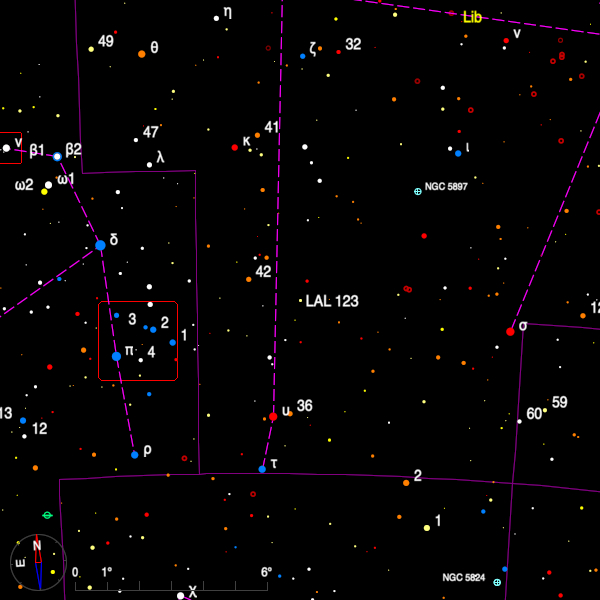
The stars are magnitudes 6.9 and 7.0 and were 9".3 apart in 2016 at PA 302 degrees. This is an easy object for 10-cm but the possessors of larger telescopes may like to examine the B star more closely. This was found to be double by T.J.J. See and has turned out to be a binary of 61 year period. The pair passes widest separation the next few years and at the moment the stars are just 0".33 apart - calling for at least 40-cm to resolve - and they have visual magnitudes of 7.0 and 8.2.
The A component is an even closer pair and was found by speckle interferometry. CHR 232, at 0".1 and a period of 16.47 years, is beyond all but the largest apertures especially as there is almost a two magnitude difference in the brightness of the components.
Bob Argyle - Double Star Section Director
May 2023 - Double Star of the Month
STF 1850 (14 28 33.239 +28 17 25.9) is a wide and fairly bright pair which can be found 3.5 degrees WNW of the spectacular pair epsilon Boötis also known as Pulcherrima - 'most beautiful' (see the column for May 2020).

The stars have changed little in relative position since they were catalogued by F. G. W. Struve and they are currently separated by 25" in PA 263 degrees. Although both are given spectral class A1V by the Washington Double Star catalog (WDS), the stars are magnitudes 7.1 and 7.6. They are rather distant, and Gaia DR3 gives the mean distance of the two as 873 light-years with an uncertainty of 1% in each case.
SHJ 263 (18 17 51.13 -18 47 54.6) sits in the yellow area marked Star Cloud M24 in The Cambridge Double Star Atlas, although it is not labelled. It is probably more accurate to define SHJ 263 as a foreground grouping of stars.
The main components are 6.8 and 9.3, separated by 54" in PA 11 degrees. The WDS lists six other companions of magnitude 12 and 13 within 30" of A and B. The only entry in Gaia DR3 for this group is that of the primary star which is given a distance of 1038 light-years whereas the distance of the star cloud as a whole is given as 10,000 light-years in the on-line literature.
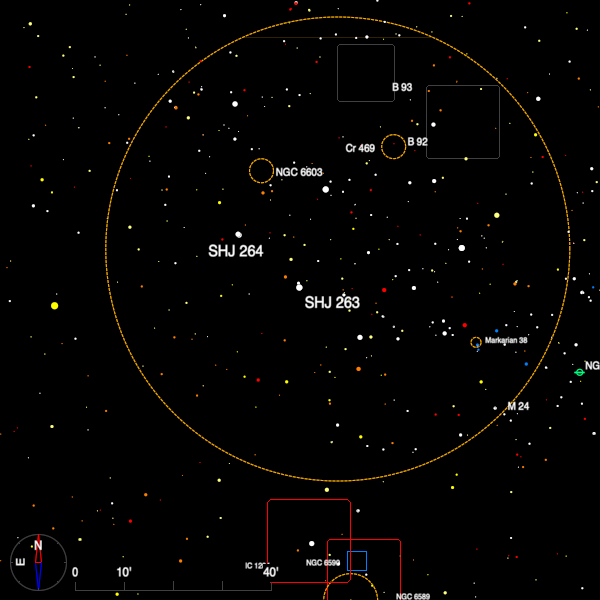
Twenty minutes NE is SHJ 264 (18 18 43.26 -18 37 10.8) and the bright pair is called AC. These stars are magnitudes 6.9 and 7.6 with a separation of 17" in PA 51 degrees.
S. W. Burnham has added a couple of more difficult tests for 25-cm aperture. A is a close pair, the companion (B) is magnitude 8.2 and only 0".5 distant from A and has moved from PA 155 degrees in 1878 to a current value of 136 degrees. Some years before this, Burnham had noted a 13.1 magnitude star (D) 6" away from C whilst Philip Fox added a 10.8 at 145" from A.
The primary star is a B0Ib supergiant and Gaia DR3 gives distances of 1826 and 4672 light-years respectively for A and B.
Bob Argyle - Double Star Section Director
April 2023 - Double Star of the Month
In the constellation Coma Berenices, in addition to the famous cluster of galaxies, there is also a grouping of naked-eye stars about 13 degrees north of the galaxy cluster. Taking the pairs 12 and 13 Comae and 14 and 16 as the vertices of an isosceles triangle, then the third vertex is occupied by STF 1633 (12 20 41.33 +27 03 16.4) a beautiful pair described by Webb as Very pretty. Solitary.
Observing it with a 21-cm reflector I found the colours to be yellow and delicate light blue.
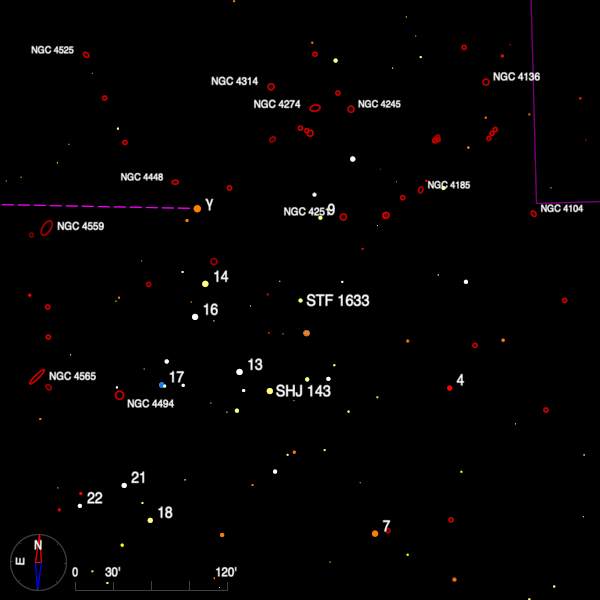
Of the four bright stars in the 'triangle' only 12 appears to be in the double star catalogue. Also known as SHJ 143, this is a wide, unequal pair in 15-cm (magnitudes 4.9, 8.9, 167 degrees, 65") which should also show the more elusive 11.8 magnitude star at 57 degrees, 37" to A.
Just over a degree south of the Sombrero galaxy (M104), and over the border into Corvus is STF 1669 (12 41 16.22 -13 00 53.6) a beautiful visual double which turns out to be at least a physical quadruple star under the gaze of the spectroscope.
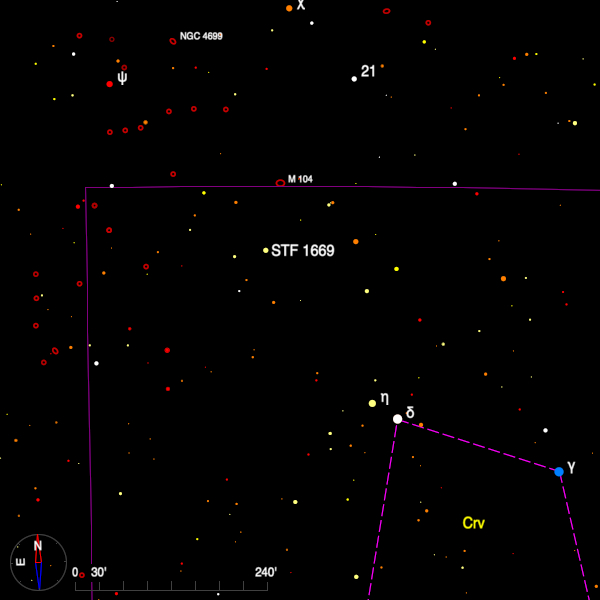
The AB components are both magnitude 5.9 and the current position and angle and separation is 314 degrees and 5".3. This shows a change of +15 degrees and -1".6 since being measured by Struve in 1828.
A third star (C) of magnitude 10.3 is 46" away in position angle 228 degrees. Strangely, Gaia DR3 records similar values for the trigonometrical parallax of stars A and C (equivalent to a distance of 266 light-years) whilst the B component is significantly nearer us (235 light-years) but is certainly regarded as physical by Dr. Andrei Tokovinin is his Multiple Star Catalog (MSC). The MSC notes that A has a period of 44.5 days whilst that of B is 3.15 days.
Bob Argyle - Double Star Section Director
March 2023 - Double Star of the Month
At the extreme eastern edge of Ursa Major, where it projects slightly into Leo Minor, there is a triangle of three naked-eye stars - 42 and 43 Lyn and a brighter but unlabelled star of Vmag 4.8 which turns out to be HD 82741. About a degree south of 42 Lyn is STF 1374 (09 41 21.88 +38 57 01.9) which is a long period visual binary.
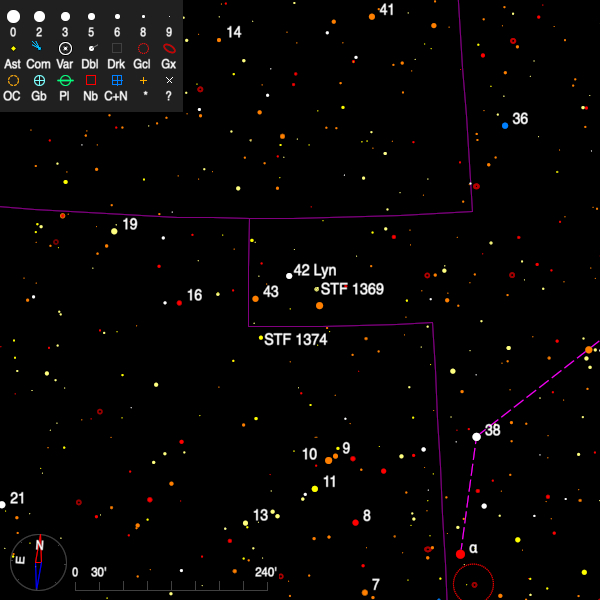
Since being measured by F. G. W. Struve (275 degrees, 3".3) the pair has closed slightly with increasing angle and is now to be found at 312 degrees, 2".8. This motion is apparently sufficient to allow the calculation of an orbit with a period of 1815 years.
This is a relatively unequal pair with magnitudes of 7.3 and 8.7 given in the Washington Double Star (WDS) catalogue. In the neighbourhood is STF1369 (7.0, 8.0, 150 degrees, 25".1) which is just north of HD 82741. Another star of magnitude 8.4 lies 116" distant and the A component is the close pair COU 2084 with a period of 50 years and a current separation of 0".1.
SEE 115 (09 37 12.65 -53 40 06.6) lies in southern Vela near the border with Carina. It sits neatly at the centroid of the isosceles triangle formed by φ, L and κ Vel.
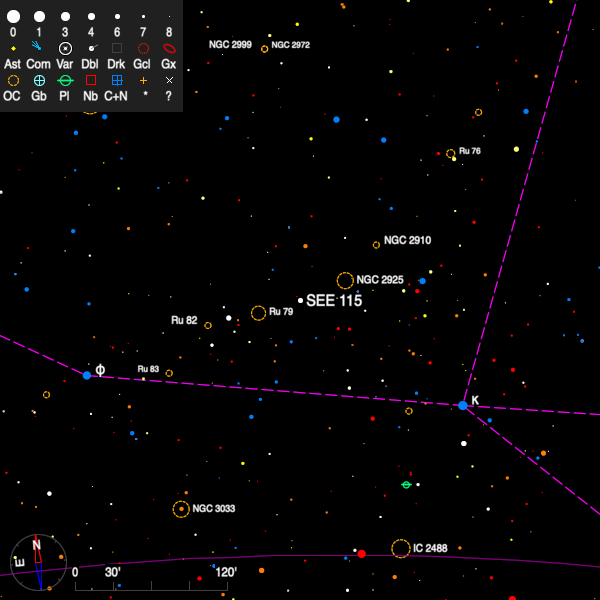
It was discovered by T. J. J. See, but in the 125 years which has elapsed since then the position angle has only increased by 8 degrees whist the separation remains at 0".7. This is a good test for a 20-cm aperture as the stars are magnitudes 6.1 and 6.3.
Although it has an entry in Gaia DR3, there is no information on either parallax or proper motion even though a relatively wide pair such as this might be expected to have been resolved satisfactorily by this stage of the satellite mission.
Just half a degree WNW is the open cluster NGC 2925 some 10'x10' in size and discovered by Sir John Herschel.
Bob Argyle - Double Star Section Director
February 2023 - Double Star of the Month
One and a half degrees just east of the fine but unequal binary pair delta Gem (see this column for February 2013) is the pair STF 1108 (07 32 50.63 +22 53 15). The star is displayed on page 8 of the second edition of MacEvoy and Tirion's fine Double Star Atlas (CUP) but without a label. Having checked back over my file of measures I note that this pair does not appear in it, nor does it appear in my earlier visual survey carried out with a 21-cm in the late 1960s.

The Washington Double Star catalogue gives the visual magnitudes as 6.6 and 8.2 whilst Gaia DR3 notes G mags of 6.3 and 8.8. There has been little motion since the pair was found by F. G. W. Struve. DR3 notes that the parallaxes are the same within the errors (and indicate a distance to the pair of 643 light-years) although these are some ten times larger than might be expected for stars of this brightness.
Half a degree south is the unequal, wide pair 63 Gem and about a degree to the south-west is STF 1081 (7.7, 8.5, 204 degrees, 1".9, slowly increasing)
2 Pup = STF 1138 (07 45 29.14 -14 41 25.7) lies in a string of naked eye stars which stretch about 30 minutes of RA along the line of south declination 15 degrees. Other objects in this area include M46 and M47 and the binary STF 1104 (see this column for February 2020). STF 1138 is about a degree due east of M46 and is a beautiful, easy pair for the small aperture.

During a visual survey carried out in the late 1960s I found colours of yellow and lilac whereas Admiral Smyth records hues of silvery white and pale white for `2 Argo Navis'. The stars of magnitudes 6.0 and 6.7 were separated by 16".7 at PA 340 degrees when I measured them in 2015, having closed from 17".4 when measured by William Herschel in 1782.
A third star of magnitude 10.6 lies 100" away in PA 229 and is some five times further away than the stars in the pair. They both have very precisely determined parallaxes thanks to Gaia DR3 which puts them 279 light-years away with an uncertainty of about 1 light-year.
Bob Argyle - Double Star Section Director
January 2023 - Double Star of the Month
STF 845 lies in Auriga (06 11 36.59 +48 42 39.6) and is also known as 41 Aurigae and it is also H 3 82, observed by William Herschel in November 1782 and recorded by him as a pretty double star
. It is a beautiful pair for the small telescope. The writer first saw it in 1969 using the 12-inch reflector of a friend. At x208 the colours were noted as yellow and lilac. The Washington Double Star (WDS) catalogue gives the spectral types as A1V and A6V.

James Dunlop found the 30th entry in his catalogue in 1826. It is located in Pictor at 06 29 40.03 -50 14 20.7 some 2.5 degrees NNE of Canopus. It offers a fine sight to the small telescope user.
The stars are magnitudes 6.0 and 8.0 and at present they are separated by 11".5, being 14" apart when observed by Dunlop. The position angle has hardly changed between these two epochs and is currently 312 degrees.

In 1871, Russell, observing with an 11-inch refractor at Sydney Observatory, found the primary star to be a close double. R 65 has a period of 111 years according to Docobo and Ling in 2021. The stars are almost equally bright but according to the orbit, which is extremely eccentric, the separation never exceeds 0".7 and, at times, drops to 0".012 which was the case in mid-2021. By 2027 the stars will be at least 0".4 apart.
In the 1890s Harvard Observatory was site testing in the Peruvian Andes and was using a 13-inch refractor. This telescope discovered several hundred new double stars amongst which was the fainter companion of DUN 30. This has also turned out to be a binary pair of period 101 years, giving a predicted position of 224 degrees, 0".44 in early 2023. The stars have visual magnitudes 8.0 and 8.7.
Bob Argyle - Double Star Section Director